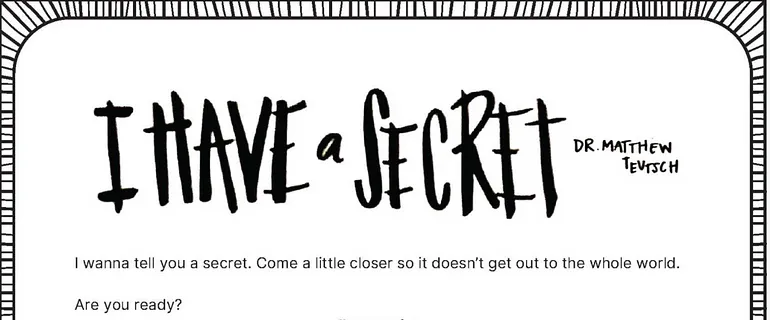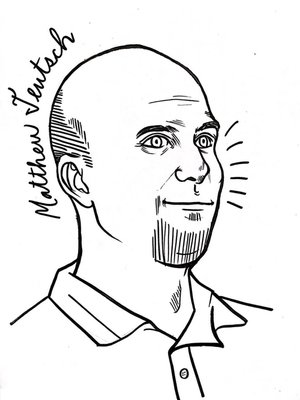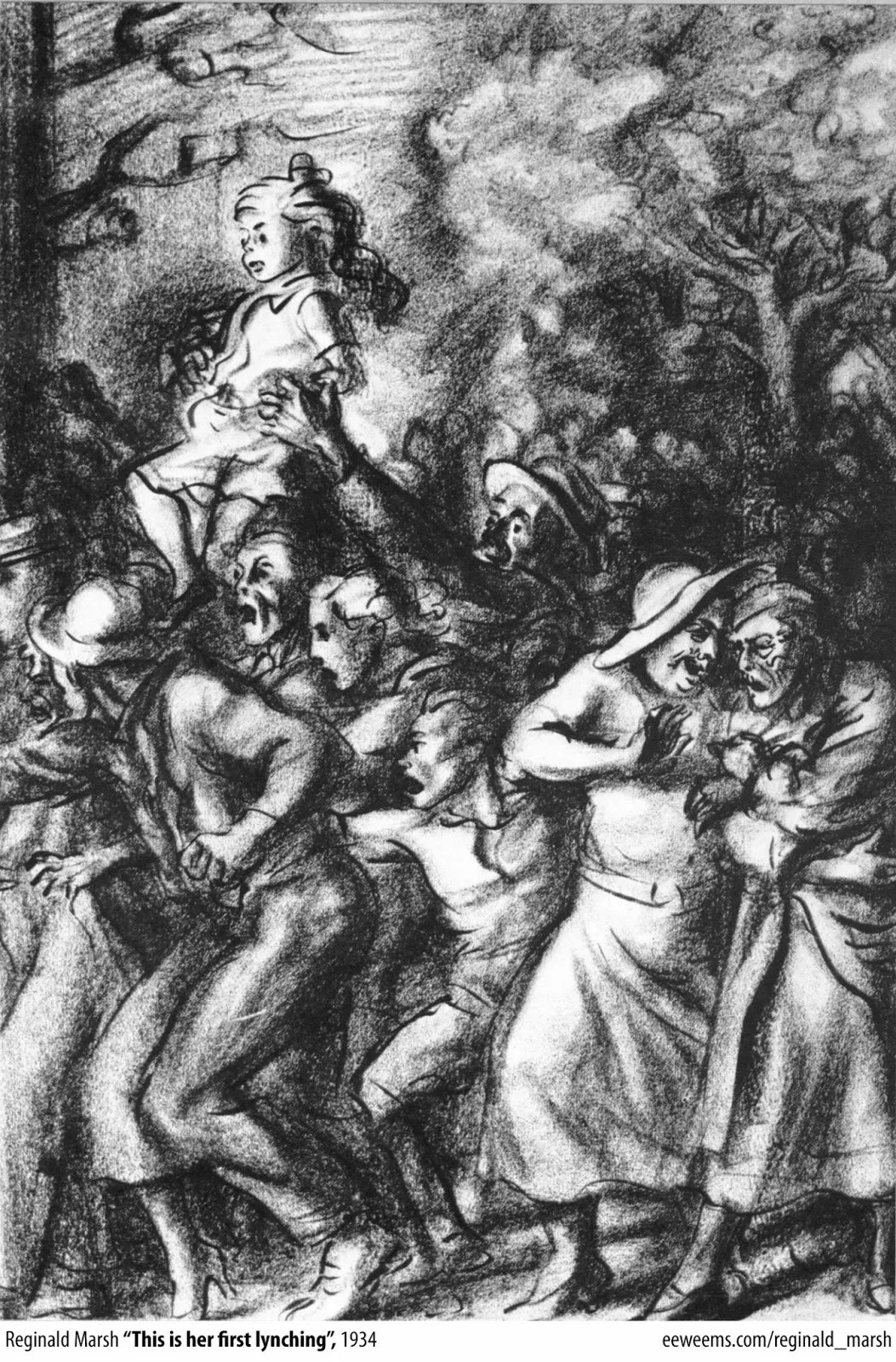
Matthew Teutsch.
“I Have a Secret.”
July 15, 2024.
© Matthew Teutsch.
Used by permission.
All rights reserved.

Are you ready?
 During the summer of 2020, following the murders of George Floyd, Breonna Taylor, and Ahmaud Arbery, I wrote an essay entitled “I Have a Secret.” The essay appeared in
Down Yonder ‘Zine in the first part of 2022. Unfortunately, the zine’s site is down, so the essay, with great illustrations by Rebekah Cardova, cannot be accessed. You can use the
WayBackmachine to see the site,
but you cannot read the essays in the zine. So, today I wanted to share the essay with you. After you read it, check out the
essay I did about the writing process for “I Have a Secret.”
During the summer of 2020, following the murders of George Floyd, Breonna Taylor, and Ahmaud Arbery, I wrote an essay entitled “I Have a Secret.” The essay appeared in
Down Yonder ‘Zine in the first part of 2022. Unfortunately, the zine’s site is down, so the essay, with great illustrations by Rebekah Cardova, cannot be accessed. You can use the
WayBackmachine to see the site,
but you cannot read the essays in the zine. So, today I wanted to share the essay with you. After you read it, check out the
essay I did about the writing process for “I Have a Secret.”
I wanna tell you a secret. Come a little closer so it doesn’t get out to the whole world.
Are you ready?
I’m a racist.
I knew I was racist before a white woman accosted Christian Cooper in Central Park, weaponizing her white tears and claiming Cooper was terrorizing her.
I knew I was racist before the state-sanctioned murder of George Floyd when officers kept a knee on his throat for over eight minutes as he cried out for his mother.
I knew I was racist before the state-sanctioned murder of Breonna Taylor who would’ve been 27 today at the hands of officers who shot her dead, in her home.
I knew I was racist before the lynching of Ahmaud Arbery when three white men hunted him down in the street, shot him, and stood over him screaming, “F’n N.”
I’ve known that I’m a racist for a long time. It’s nothing new to me.
I’m racist because I’m like the little two-year old boy in Klan robes at a Klan rally in Gainesville, GA, in 1992. He stands there, looking at a Black Georgia State Trooper’s riot shield. The trooper stares down at the boy, but the boy is oblivious. He only holds out his hand as his fingers trace the outline of his own reflection, narcissistically enraptured by his own appearance. He’s self-absorbed, looking out for himself. If it doesn’t affect him, then it doesn’t matter.
I’m a racist because I’m like the little girl in Reginald Marsh’s This is Her First Lynching. The crowd hoists her up in the air so she can see the murder occurring off the canvas. They look to the left as the fire from the burning Black man or Black woman, possibly with a baby still nestled within her, becomes enveloped in the flames. The glow of the fire shines on the young girl’s face and the faces of those in the crowd.
The girl appears innocent, staring inquisitively at the scene in front of her. The faces of those holding her aloft and of the people around her, grotesquely contort into visages of hate. Each of these children, I imagine, could concur at some point with Lillian Smith’s words at the beginning of Killers of the Dream (1949): “Even its children knew that the South [Nation] was in trouble.” What they did with that knowledge, though, is the question.

I’m a racist because I’m like the boy on stage at Madison Square Garden in February 1939. He stood on stage, with other youth, wearing a Hitler Youth uniform as he partook in the German American Bund’s. “Pro American Rally.” He, along with over 20,000 others gathered that night, said the Pledge of Allegiance and sang along to the National Anthem. He listened to Fritz Kuhn, the Bund’s leader, tell him, “We, with our American ideas, demand that our government shall be returned to the American people who founded it.… If you ask what we are actively fighting for under our charter, first, a socially just, white, Gentile-ruled United States. Gentile-controlled labor unions, free from Jewish Moscow-directed domination.”
The boy stood there as Isadore Greenbaum, a Jewish man who came to hear what the Bund would say, rushed the stage and screamed, “Down with Hitler!” When the Bund’s security pounced on Greenbaum, breaking his nose and giving him a black eye, he rocked back and forth laughing joyously, leaning in to his neighbors ear and saying something “funny.”
I’m a racist because the nation and region that raised me also had a hand in the genocide of millions of Jews, Blacks, gays, Roma and Sinti, individuals with disabilities, and others during World War II under Nazi Germany’s policies. In the Prussian Memorandum, the predecessor to the Nuremburg Laws, the Nazi writers directly mention Jim Crow laws, specifically when “German women shamelessly consort with Negroes.” They go on to add “that the southern states of North America maintain the most stringent separation between the white population and coloreds in both public and personal interactions.” While the Nazis looked to America “as the innovative world leader in the creation of racist law,” James Q. Whitman notes that America’s anti-miscegenation law was “too harsh to be embraced by the Third Reich.”
My daughter and I performed in a play earlier this year entitled Number the Stars. The play is about Danish citizens, during World War II who resisted the Nazis and helped to save the lives of countless Jews from death in concentration camps or in the streets. Her character, Anne Marie, was the protagonist. Throughout, Anne Marie learns about the treatment of Jews, struggling to understand it, and she ultimately shows courage in helping to save her friend Ellen Rosen, her family, and others by getting them safely to Sweden.
Anne Marie chose to act, against all the impulses and fear that told her not to. She acted because she knew what the Nazis did was wrong. She acted to protect her friend, Ellen. She acted because if she didn’t, Ellen, her family, and other Jews may have died. She acted because she knew the system was wrong, and she defied that system. She refused to let her conscience get lulled to sleep by Hitler and the Nazis.
Lillian Smith begins “The White Christian and His Conscience” by pointing to the historical sins of America. She writes, “Ever since the first white Christian enslaved the first black man, the conscience of America has been hurting.” I’m a racist because I have benefitted from this moment and I allowed myself, for far too long, to let my conscience rest easily under its power. Smith writes that “Hitler was shrewd enough to know that a conscience is a heavy thing to take with you on a journey back to savagery,” and this same shrewdness exists in America.
Smith wrote this essay during World War II, a war where men and women, both Black and White, fought for democracy. Greenbaum joined the Navy and fought Nazis in Europe. The difference was, though, that Black soldiers couldn’t fight alongside White soldiers. The difference was, though, that Black soldiers fought to show they were citizens just like the White soldiers. The difference was, though, that it took almost twenty years after the end of World War II for the Civil Rights Act to get passed. It took protests after the assassination of Martin Luther King, Jr. in 1968 for it to be expanded to cover hate crimes and fair housing.
Propaganda details this, and much more, in his song “It Ain’t Working.” He raps,
And they couldn’t help but notice the striking resemblance
Between these Jewish ghettos and the one in they own Chicago.
I’m a racist because for the longest time I was like the Germans that Smith mentions in her essay. She writes,
Anne Marie’s conscience didn’t waver. Anne Marie’s conscience prevailed. Anne Marie fought the impulse to drop her conscience and protect her own self. She looked away from the mirror. She looked to the left. She looked to the right. She looked up.
I’m still a racist, but I’m working. I’ve been working, almost two decades probably, to cure myself of the roots of racism that have spread so deep within me that whenever I think they’re gone they choke me, dragging me back down into the earth from which they spring like Kudzu along the highway.
I’m still a racist, but I’ve learned to look at myself and examine how my race affects me. I am white. I cannot deny that. I am white. That is me. I am white. I walk into a store; I don’t get followed around. I am white. I use the self-checkout, pick up my items in my hand without a bag, and I walk out of the store. No one stops me and asks to see a receipt. I am white. I put in an application, any application, and my name immediately tells someone I am white, which means I have a better chance of getting the loan or getting an interview over Black and Brown applicants. I am white. Unlike a Black woman I spoke with who told me she doesn’t want to get a car because she is afraid of being pulled over and what might happen, I drive down the road without having to worry about whether or not I’ll get pulled over by the police. My kids are white. I do not have to tell them to be respectful, watch their movements, watch their words, around police officers.
Last year, we lived in Bergen, Norway, half a world away from the South where I’ve resided my entire life. My daughter met her best friend in Norway. Her parents are from Burundi, and in Norway, Noelle faces racism and discrimination in her everyday experiences. When the protests started in the wake of George Floyd’s murder, my daughter and her friend started talking more and more about Noelle’s experiences in Norway as the Black daughter of immigrants. Noelle told her about times when older white Norwegians would tell her to go back to her home country, would assume that she doesn’t speak Norwegian because she is Black, and assuming that she knows someone because she is Black and the other person is Black. We hear these same stories in America, and the point is, this is not just a Southern pandemic, not just an American pandemic. It is a world pandemic, and the majority of us are infected.
I’m still a racist, but I’m getting better. Daily, I’m eradicating the roots that lie deep within me. Daily, I’m educating myself. It’s not up to others to educate me. Writing about this moment, DiAnne Malone in an essay entitled “For the Black People Still Breathing,” says,
I’m a racist, but I’ve been learning. I’ve been untangling. I’ve been putting in work. It hasn’t always been easy. It hasn’t always been pretty. It hasn’t gone the way I expected it would. I’ve made mistakes. I’ll make more. However, I know that I cannot close up because if that happens, I will not be able to reach out to others, I will not be able to, as Lillian Smith puts it, “build bridges to other people: to one, then to one more, and on and on.” That is what Christ calls us to do, right? Build bridges. Love our neighbor. Be the good Samaritan. Listen to one another. Work towards equity. That is the opposite of racism, working towards equity for all. Before we can do that, we have to face the ghosts of the past and we have to face ourselves.
I’m a racist, and I have a long way to go to rid myself of the deeply embedded roots of racism that have strangled me for my entire life. I am like the woman that Smith talks about in Killers of the Dream who wants to end segregation and working towards that chooses to defy the law and break bread with Black women. Smith states, “Though her conscience was serene, and her enjoyment of this association was real, yet she was seized by an acute nausea which disappeared only when the meal was finished. She was too honest to attribute it to anything other than anxiety welling up from the ‘bottom of her personality,’ as she expressed it, creeping back from her childhood training.”
The woman felt like she would vomit sitting at the table and eating with Black women. The lessons she had learned reared their heads and battled with her “serene conscience,” causing her anxiety. As George Yancy puts it, the woman’s experience “demonstrates that having a serene conscience or having an epistemologically correct belief does not ipso facto militate against the impact of one’s white’s racism.” It arises from the culture we inherit. From birth, we can feel it “seeping through every level of our life like a slow-spreading poison” as Smith put it.
I’m a racist, and I know it. I’m working to cure the poison that has seeped into my very being. I’m working to eradicate the deep roots in my soul that have proliferated and spread exponentially. I’m working to plant a fruitful, thriving tree for all, a tree with roots that feed on love, compassion, empathy, understanding, and produce equity and equality for all.

Written by Matthew Teutsch
Here, you will find reflections on African American, American, and Southern Literature, American popular culture and politics, and pedagogy.

Text prepared by:
- Bruce R. Magee
Source
Teutsch, Matthew. “I Have a Secret.” 10 July 2024. Medium. 22 July 2024. <https:// interminable rambling. medium.com/ i-have-a-secret-bc7638a0d45d> © Matthew Teutsch. Used by permission. All rights reserved.
